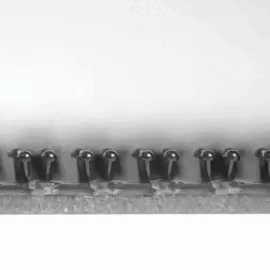Attaching to the Drone
The DRI can be attached to the drone using M2 mounting holes or double-sided adhesive tape or velcro. When using velcro, we advise you to use 3M Dual Lock with interlocking mushroom-shaped heads. They slide past each other to close with a snap and peel apart easily when you need to separate them by simply pulling the strips by hand.

Proper Location and attachement advice
Please watch out for these potential issues when looking for a suitable location and the type of attachment of the DRI:
- If you are using a double-sided tape, please follow the manufacturer recommendation, as some require some time curing for proper attachment.
- If mounted by double sided tape, don't place DRI over a curved surface because it might come off during flight.
- If mounted by double sided tape, don't place DRI on a soft material that can bend during mating (such as plastic covers). The double sided tape may not hold properly.
- It is recommended to place DRI in accessible locations. You should have the LEDs visible.
- Please check mounting drawing containing depiction of cables coming out of the device to not interfere with existing wirings.
- When using external antenna please do not choose location with any metal surfaces and carbon tubing to prevent antenna detuning.
- For internal antenna please ensure that the antenna is not placed directly on any metal or carbon surfaces to prevent detuning of the Bluetooth antenna.
Antenna selection
If you have chosen DRI with a built-in antenna, there's no need for you to pay attention to selecting an external antenna.
If you have decided to use DRI with a U.FL connector for an external antenna, we recommend you using our antenna, which can be bought here. Please note, that this antenna needs to be attached to a plastic surface. If the location where you intend to position the antenna is not made of plastic, you should opt for an alternative antenna that can be suspended freely in the air instead of being glued.
If you want to use antenna by your choice, please take in mind you need to determine the frequency band, check the radiation pattern (you need to use an omnidirectional antenna to satisfy the regulations), check the gain and look for interference possibilities.
Disclaimer
We kindly advise that our company cannot assume responsibility for the installation of our product by the user or any potential loss incurred as a result. While we strive to provide comprehensive guidance and support, the responsibility for proper installation lies with the user. Should you require any further assistance or clarification, please do not hesitate to contact our customer support team. Your understanding is greatly appreciated.